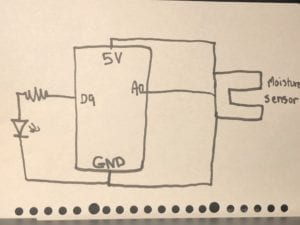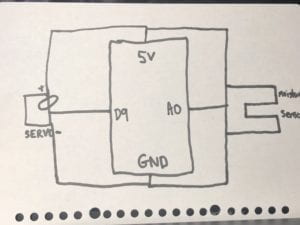Overview
Overall, this circuit was the most complex so far this semester, not in the amount of wires and connections, but the most tweaking and altering of the code to adapt an Arduino analog in out serial code (because we used the LED as an indicator on whether there was or was not moisture). We first tested the moisture sensor with code that the moisture sensor link provides, testing the wire hook up and reading the serial monitor. Then we mapped it to an LED and later Servo.
Moisture Sensor Mapped to a LED

The circuit itself to set up was not too difficult. The moisture sensor connected to the A0 pin, the 5V and the ground. The LED connected to the resistor which connected to the digital 9 pin. The LED also connected to the ground. For the code, we took the example code Analog In Out Serial, which we previously have used to map a potentiometer to an LED. We also had to map the moisture sensor to the light, which was difficult to test its max value or input scale, unlike the potentiometer which is quite easy to test its maximum and minimum. We tested the moisture sensor in the air, on the back of our hands, on our palms, and in a wet paper towel, the highest reading I recorded was almost 700 (although it was restricted to what we personally found), the lowest was 0 in the air and the back of our hands, the palm ranged from about 25- 230. We mapped this to the LED which was 0-255 and read the serial monitor for showing us moisture (input) and light (output), which we relabeled using serial.print. As the sensor recorded moisture the light came on and off at varying brightnesses.
Video of Working Circuit:
In the video we added a bit of water to the palms of our hands to make them damp/moist.
Moisture Sensor Mapped to Servo

We also mapped the moisture sensor to the Servo motor to test a second output. For this Servo connected to pin 9, 5V and ground and the moisture sensor stayed the same. As we introduced moisture to the senior with the same methods, back of hand, palm, air, and wet paper towel. As we placed it to our palm the sensor picked up moisture and the motor began to turn.
Video of Working Circuit:
In the video we added a bit of water to the palms of our hands to make them damp/moist.
Question 1:
We intended to assemble a circuit that when the moisture sensor sensed moisture would turn the light on at different brightness depending on the amount of moisture. Similarly, we intended to assemble a second circuit that when detecting moisture caused a motor to turn. If the light and moisture combo were to be used in a practical manner, it could be used with agriculture and irrigation letting workers know when the moisture levels of soil have reached a certain degree and no longer need to be watered. It could also be helpful for biology research experiments where moisture levels need to be controlled as a variable of an experiment. The motor system is more practical for automatic large scale agriculture and irrigation where sensors and satellites control all production factors including water and fertilizer. The motor can be particularly helpful for triggering a valve or system to turn off when moisture levels reach a certain level.
Question 2:
Code could be compared to a recipe or instructions because the code gives you the basic instructions on how to get the job done, but in order to change the product/output for your use or preferences you must alter certain ingredients quantities while cooking. And you can add or take out thinks you like or don’t like depending on your purpose. Similarly code gives you a basic foundation that you should flow to get a certain outcome, but personal preference and customization for specific purposes can enhance the product for your specific use.
Question 3:
Personally, I agree with the article Language of New Media, Manovich explains the third of five components of changes in new media as automation. Automation is the change that I see the most in my everyday life especially in photoshopping apps or social media that have tools to use filters and automatically change an image through doing a certain function like adding a color filter, or stylistic, of light layer design, or even just upping the contrast. It is an automatic function in the fact that it is predesigned to do the same thing to any photo it is applied to. This would be a form of low-level automation.
As a result of how computers influence new media, human behavior has changed based on the ease and automation of much of new media. People have become obsessed with creating a perfect social media image and constructing an unrealistic version of themselves online. I think this is partly do to how easy it is to alter a photo and filter less appealing aspects. Automations of this altering process allows any person not just someone who is advanced in the realm of editing and technology to alter their own picture. Once people see the ideal edited photo it makes them start to think that is the standard/ norm, not the true photo of themselves. This automation computers have allowed us to have has changed how humans think about themselves and the ideal image of themselves, creating an almost unachievable goal for self image.